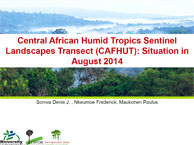Western Borneo Sentinel Landscape: The three regencies this Sentinel Landscape is concerned with are: Kapuas Hulu, Sintang and Ketapang. These regencies represent a gradient of forest degradation balanced by traditional agroforestry systems which are impacted by the development of monoculture plantations, mainly oil palm.
The regencies and provincial government have made commitments to conserve their natural resources, but the challenge is to ensure this can be done while creating economic development that ensures poverty alleviation and supports the needs of the local population.
The potential impact of the growth of oil palm plantations remains unclear and presents a major challenge to the regencies, which is faced with the need to mitigate the impacts of economic development whilst maintaining ecosystem services, preserving the environmental and social functions that they provide.
Sumatra Sentinel Landscape: The proposed transect includes large parts of Sumatra's National Parks and protected areas alongside globally significant biodiversity (including Sumatran tiger and orangutan release sites on the Riau side of the transect), where local use of very rich flora and fauna is extensive. Hilly and lowland areas of the transect are mosaics of dynamics land uses by small holder farmers as well large as scale operators.
Site selection
Four sites finally selected (2 in Borneo, 2 in Sumatra) illustration. The forest transition theory they encompass representative vegetation in Indonesia and representative landscapes: Non-swamp lowland forest types, Series of degradation and secondary regrowth, Traditional agroforestry and swidden agriculture systems, and more recent land uses such as smallholder timber or oil palm.
The sentinel Sites
- Batang Lupar
- Natural forest, logged-‐over forest, various secondary forest, sacred forest sites
- Swidden agriculture and rubber garden, Tengkawang forest
- Dayak people, mostly Iban Dayaks
- Settlements near river, sometimes access by roads (ex logging roads)
- Mostly longhouses (juxtaposed private living quarters "bilik", each bilik occupied by more than one household.
- Most biliks have one or several family members working in Malaysia or in the city of Lanjak.
- No electricity in the hamlets.
- Health facility, education facility and market are located in Lanjak, about one hour driving by motorbike or car.
- Most villagers speak Iban language, only few speak Bahasa Indonesia.
- Mentebah
- Natural forest, logged-‐over forest, various secondary forests
- Swidden agriculture and rubber garden, gold mining on some river banks.
- Mostly Suruk Dayaks
- Most seElements near river, some near roads. Better road conditions compared with Batang Lupar, including proximity of the main Sintang – Putussibau asphalt road.
- Mostly individual houses.
- Electricity (PLN), elementary school and village midwife in Tanjung Intan village.
- Most villagers speak Bahasa Indonesia.
- Batang Merangin
- Major land cover type is young rubber agro forest; few smallholder oil palm gardens, paddy fields. Some remnant of natural forest
- Customary forest within the site
- Mostly private land, smallholder farms
- Terrain mostly undulaong
- There are 10 villages within the site with several others around within 10 km buffer area; mostly local villages
- Accessibility moderately good, several main asphalted roads, with some 0les accessible only by foot.
- Sarolangun
- Major land cover types and land uses are smallholder rubber gardens, young oil palm and smallholder forest planta0ons (HTR Hutan Tanaman Rakyat)
- Parts of the land is privately-‐owned and some parts are owned by plantation concessions.
- Terrain mostly flat
- There are approx. 10 villages found within the site, majority is transmigration settlements with few local villages
- Some inaccessible roads during rainy season
What criteria used to select villages
- Potential villages identified first through existing base maps and national census statistics.
- Characteristics later checked in the field and through discussions with local partners
- In Kapuas Hulu, Borneo, sometimes difficult to find 10 villages within a 10 x 10 km square sample
- In Jambi, Sumatra, the density of villages is higher.
- Hamlets (Dusun) treated as separate villages
- In Borneo we try to ensure balance between villages according to distance to the road and market access.
- In Sumatra we try to ensure balance between traditional local villages and new settlements inhabited mainly by migrants.
Baseline Implementation
LDSF
Land cover map (2013), LDSF and village sampling, example of Batang Lupar
Village Level Surveys
Method used to gather village level information:
- FGD with key people from the villages (e.g. village head, customary leaders, farmer group heads, village authorities, village elderly)
- For each village, 30 households selected by random from the total HH heads listed.
- In the case of village having several attached hamlets (dusun), hence large number of population, hamlets are treated as separate villages.








